Part two of an interview with Ken Cooke, aka Johnny Volume – guitarist, songwriter and driving force behind early Auckland punk rock band The Scavengers, the group that recorded punk classics such as ‘Mysterex’ and ‘True Love’. In this part he discusses the Suburban Reptiles, recording in Australia and Europe with The Marching Girls, and “Lou Reed’s Les Paul Junior”.
--
Tell me about your time with the Suburban Reptiles: for some reason, I had always thought that Billy Planet had asked you, but you told me that you asked the band? I can understand the rest of your band were less than happy.
I had nowhere to live. I’d been sleeping wherever I ended up until one day I ran into you somewhere. You told me there was a spare room at [Suburban Reptiles’ guitarist/bassist] Billy [Planet]’s place in Ponsonby and arranged for me to move in. I wasn’t sure who actually lived in the house as there were rooms everywhere and always people coming and going and sleeping on the floor or hanging out on the veranda. A huge pot of brown lentils that everybody ate was usually bubbling on the stove and while you were eating it you could see through the windows the cat lady who lived next door feeding her dozens of cats steak at the table.
Suburban Reptiles practised downstairs in a padded basement. [Reptiles guitarist] Brian [Nicholls] had left so they advertised for a new guitarist in all of the guitar shops in the city. I was in Kingsley-Smith’s and saw the ad saying, “SUBURBAN REPTILES NEED A GUITARIST PH 760 226”. I thought then I might as well ask them if they wanted me to do it. By chance they’d had a band meeting that day and decided to ask me if I would play guitar. They promised me all kinds of fame and fortune, so I was in. We rehearsed for a couple of days and then headed off to the Student’s Arts Festival in Wellington for the first gig.
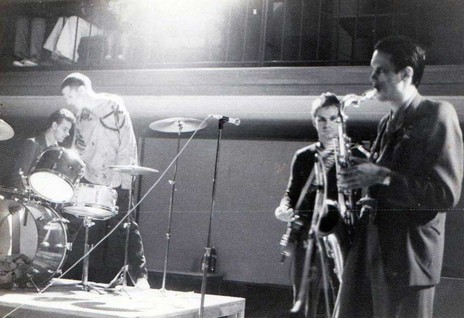
The Suburban Reptiles with stand-in guitarist Johnny Volume at the August 1977 Students' Arts Festival at Victoria University, Wellington. The band are setting up and The Scavengers' Des Truction is also seen. From left: Des Truction, Buster Stiggs, Johnny Volume and Jimmy Joy. - Photo by Stuart Page
It was totally different to what I was used to. Buster’s [Buster Stiggs] busy drumming, Billy’s thundering Gibson bass and Zero and Jimmy wailing on sax and vocals. It was like a competition to see who could fill the room with the most noise. I had the Les Paul Junior and a 100-watt Marshall but still got lost among the cacophony that I was contributing to. My job seemed to be playing a bunch of chords as loud and as fast as could possible. Lots of great energy and very much an image-orientated band. We spent ages in the dressing room with [future Idle Idols’ guitarist] Jamie Jetson and the girls putting makeup on us. The organisers kept coming into the room and frantically telling us we were supposed to be on stage. This went on for about 25 minutes. We deliberately kept the audience waiting. An old showbiz trick apparently. Once we finally did get on and made a bit of noise, the sound engineer raced across the room and screamed into my face that he would smash my head in if I didn’t turn down my amp! The room was packed, and the audience were angry at having been made to wait so long and the tension only got worse when Buster threw his drumsticks into the crowd causing injury to a girl. The next morning the papers were full of the usual “SHOCK/HORROR” routine, which resulted in me being beaten up in the toilets the next day by a bunch of hit-and-run rugby types.
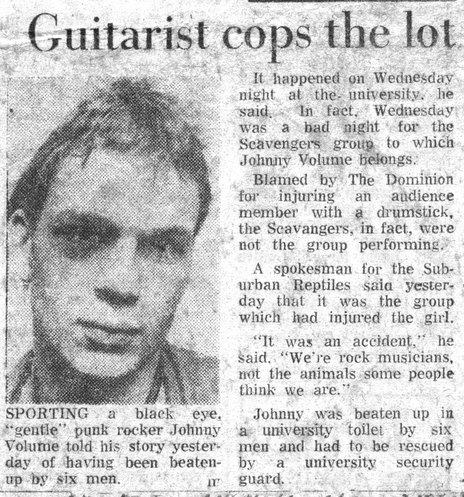
Johnny Volume cops a hiding in Wellington, August 1977. - Simon Grigg Collection
I don’t think the rest of The Scavengers were that worried as we knew we were better than them anyway, but when the recording session for the Reptiles’ first EP was organised a meeting was held and Mike, Des and Marlon asked me not to play on it. I agreed for the sake of harmony, but I did loan Billy my guitar and amp and, at the same time, quit the Suburban Reptiles. There was an article in [Rip It Up] stating that I’d been fired after the nightclub incident with Spike Bastard… but that’s another story. I actually spoke to Billy before the recording and told him it was causing too much friction, so I had to leave. Meantime, someone seized on the opportunity for a bit of free publicity, as that was the game played between the Suburban Reptiles and The Scavengers.
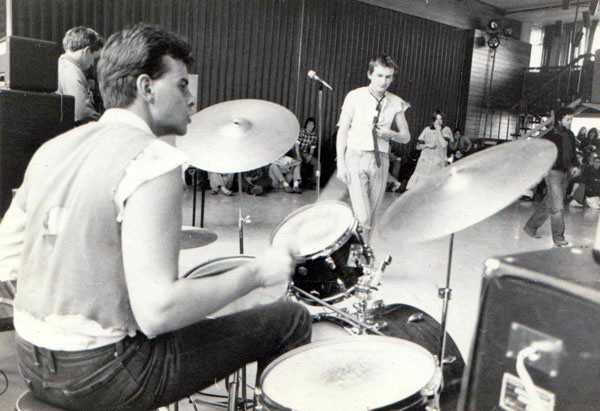
The Scavengers at Victoria University, August 23, 1977. - Wayne Hunter
Your manager Dave Schofield – where did he come from and what happened to him?
No one is too sure about this, but I have a vague recollection of Nadine [Huru] who owned the record shop in Parnell [Professor Longhair’s] being a friend of Dave’s partner Colin [Lum] who worked at Polydor. She was a fan of the band and thought Polydor should sign us.
Dave and Colin came to see us play one night and afterwards invited us back to their huge house in Grafton. He talked about organising gigs for us and we agreed to let him try. His day job was managing a TV rental shop in Takapuna and he had a crew of young surfer boys who owned panel vans that hung around. He hired them to be our road crew. They also knew where Barry Jenkin lived and took us to his house for the punk indoctrination we gave him that’s been written about many times.
The first show Dave organised was at the Takapuna RSA in January 1978. At the start of February, he was contacted by a couple of club owners, Donnie [Hooper] and Brian [Ball]. They had the lease to where [Tommy Adderley’s old club] Granpa’s had been and wanted to start a punk club there. It was to be called Zwines and they wanted The Scavengers to be the resident band. We were given a budget of $250 to decorate the place however we liked. Dave spent most of it getting huge blow-up pictures of leather men from his gay magazines and what was left went on a few spray cans for us to graffiti the walls.
The band played a lot while under Dave’s management. For a time we’d play a school concert at lunchtime, then the pub in the evening, then late night at a club.
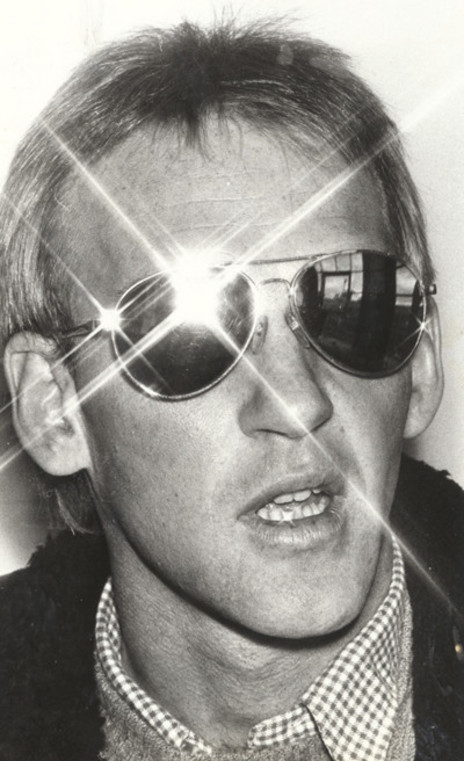
Dave Schofield, The Scavengers manager from January 1978 to the middle of the year. - Simon Grigg collection
Around this time I was living in Lorne Street in the inner city, above the first McDonald’s (which faced onto Queen Street), a few doors up from La Charcuterie, a trendy, popular, French café at the time. It had large front windows and it seemed that whenever we walked past there around lunchtime, we’d see Dave and a couple of other guys sitting in the window drinking imported beers and eating French food. We’d stare and point while he’d gesture at us to go away. At the beginning of his management, he’d begun collecting all monies and announced that he was putting us on a wage of $25 a week. Not much, but it was explained to us over a large bowl of scallops and family-sized bottles of bourbon in an expensive Ponsonby restaurant that we didn’t need money for anything, as drinks were always free! We said, “Yeah sounds good.”
Now he was telling us that he was using the money we earned to entertain “important people” and “this would get us a record deal”. Try as he might, the only offer was from K-Tel to record an album of punk cover versions with an impossible budget of something like $200. We turned it down.
Eventually, we wised up. Ronnie had introduced us to a school friend of his, a large young man who we named Doug Elephant after he asked us to give him a punk name. He managed the Uncle’s burger bar on Karangahape Road that we used to drop into late at night. The burgers and chips were always free, which seemed a good enough reason for us to say okay when he offered to manage the band. We told him that if he could organise a New Zealand tour, the job was his. Using Ronnie’s and my phone he did just that, making endless toll calls all around the country.
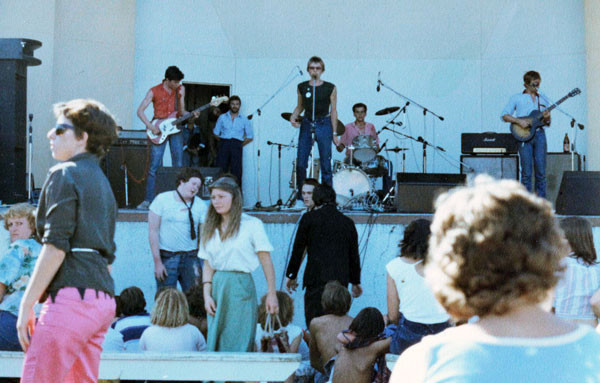
The Scavengers at the Rotorua Soundshell March 1978: Brendan Perry, Mike Lesbian, Des Truction and Johnny Volume. In front are John Noone and Jonathan Jamrag from Rooter (later The Terrorways). - Ken Cooke
However, first we had to get rid of Dave. A phone call was made and one of us fired him and arranged to meet him in the city to pay us what was due. We were expecting a huge amount of money to be left over from all of those months of playing so much. We met him in High Street outside Taste Records. Doug drove us there in his car. On the way he stopped off at his house to collect an air pistol, telling us he would be using it to rid us of the possum problem at Cotter Avenue [in Remuera] where Ronnie and I now lived. They’d been coming down the chimney and running around the house destroying and shitting on everything.
We pulled up outside the record shop where Dave was waiting. Someone in the back seat pointed the pistol at him and said, “Get in the car”. Unknown to us, a woman coming out of the United Building Society next door saw this and ran off to ring the police. Meantime, Dave walked over to the car and handed us an envelope with a cheque for $300 and then left.
We were shocked at the small amount but it was 15 minutes before bank closing time so we sped off down Queen Street in a rush to cash the cheque at the first bank we could find. There was a lot of traffic on Queen Street at that time of day, so Doug decided to double park outside the BNZ while one of us rushed in and cashed the cheque. At the same time another car pulled up alongside us and we’re looking at it thinking ‘What the fuck are these idiots doing triple parking on the main street of Auckland?’. Almost instantly we had guns pointed in our faces and plain-clothed men yelling at us to get out of the car with our hands in the air, warning us that if anyone did anything stupid, they would be shot! It was the Armed Offenders Squad. They threw us into the back of police cars, now causing a traffic jam blocking Queen street. We were all taken away separately and put in cells in Auckland Central police station. After several long hours playing good cop/bad cop they let us go.
Brendan joined. Why did Marlon leave and where did you find Brendan?
Brendan joined in September 1977. After [The Scavengers had played] at the Student Arts Festival in Wellington, Marlon insisted his new girlfriend came everywhere with us, but we didn’t want that. I think in the end there was a confrontation when we were off to a rehearsal or a gig and Mal stated, “either she comes with me or I quit the band.” It left us no choice. We drove off without them. But that wasn’t the end of it.
That night, I went to a party in Remuera with [girlfriend] Susan Hayden. I’d told her about Marlon “quitting” and how it was a bit of a dilemma – we were scheduled to go back to Wellington for Ready To Roll the next week. She said that while The Scavengers were away, she’d been to a party and met a young English guy called Brendan that she thought would be perfect for the band – and he would be at the party we were heading to.
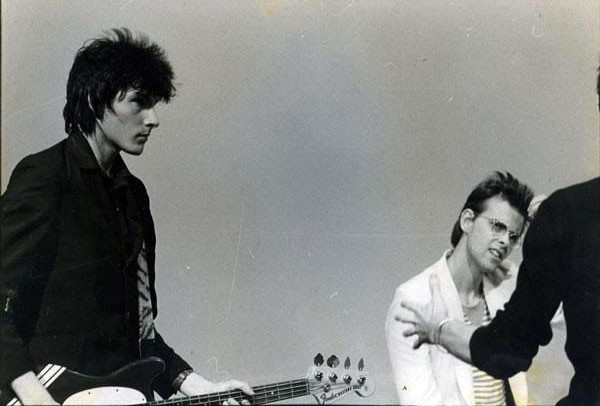
Brendan "Ronnie Recent" Perry and Des Truction recording the video for ‘First In Line’, Melbourne 1980. - Ken Cooke
It was very crowded when we arrived, but she spotted him and took me over to meet him. I liked him instantly … short haired and skinny with a great accent. I asked him if he could play bass. He said he played guitar but could learn bass really fast. I said, “Welcome to The Scavengers”.
We went to Wellington a day later by overnight train. We’d got the gig thanks to Greg Lay. I hadn’t heard from him for years when he rang to say he knew the producer of Ready To Roll and they needed a punk band as they were expecting the Sex Pistols song ‘Pretty Vacant’ was going to chart.
Brendan learned the songs off the Harlequin cassette. It wasn’t that important anyway as we were only miming. He didn’t have a bass, so we borrowed one off [Suburban Reptiles and Masochists bassist] Bones Hillman. The train was leaving about 6pm and we met at the Auckland Railway Station foyer. Des, Mike, Brendan and myself. My guitar [was being] used on the Suburban Reptiles recording and you had promised to deliver it to me at the station. It was getting very close to leaving time and you still hadn’t shown up – I was getting a bit aggravated. I had to use my Les Paul Junior on TV! Then suddenly Marlon appeared with his girlfriend and asked us where his ticket was. We reminded him he’d quit the week before and we had a new bass player. He argued that he’d played on the recording and that he should be on TV with us. In the end I’d become so angry thinking you weren’t going to show with my guitar that I told Marlon to fuck off.
I regret having to handle it that way, but we all felt really good about having Brendan in the band. Marlon had always refused to cut his long hair and of course, there’s always the “musical differences”. Then, just when I’m thinking “I’ll kill Simon the next time I see him,” your little orange Mini raced up to the station door and out you jumped with my guitar. I grabbed it and ran for the train.
Some sources say that Brendan took over vocals in February 1978, but Mike Lesbian is photographed with you at Zwines, which opened in March. Do you know when Mike left?
Mike left in March 1978 so, yes, he did play at Zwines for a week or two, but Ronnie started singing almost immediately after. We were practising at Zwines one night wondering what had happened to Mike, as he hadn’t shown up. Eventually, Dave Schofield showed up and told us that Mike had called to say he had quit. We had gigs coming up, so we decided to carry on regardless. Gill Samuels [aka Rip It Up writer Jewel Sanyo], whose place we were staying at, suggested we try her friend Tony Peake from Christchurch and she called him for us. He was supposed to fly to Auckland to try out, but something happened, and he didn’t come… I think he had just had a really good day job selling records at the university.
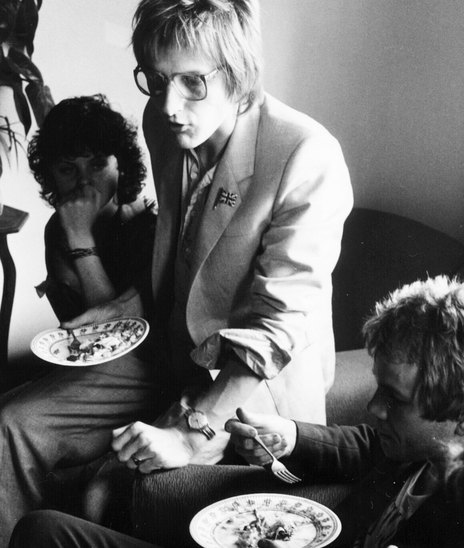
Mike Lesbian and Johnny Volume at the Rip It Up farewell to writer Jeremy Templer, 1978 - Photo by Murray Cammick
Andrew Snoid contacted us somehow and asked to audition as well. I can only remember him walking into Zwines with a telephone receiver hanging out of his pocket and I suppose we did a song or two with him but were not convinced so the next day the three of us rehearsed by ourselves. I said, “Fuck it, we’ve always sung backing vocals so let’s share the vocals between us.” I sang the first song on the list. I never wanted to be a singer, but the band was important to me, so I gave it a try. I was in tune and in time, but I hated hearing my voice. Then Ronnie sang and it sounded great and it was obvious from that moment that he was our new singer.
How many gigs did Buster Stiggs play with you?
Buster played only two or three gigs with us. The first was at the Auckland University and then a Saturday afternoon at the Windsor and possibly one night at Zwines around the same time.
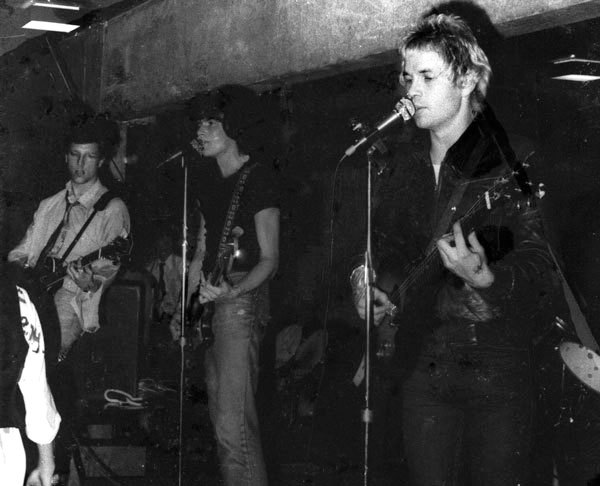
The Scavengers at Auckland University with Buster Stiggs (left) guesting, 1978
In late 1978, after series of farewell gigs, The Scavengers moved to Australia, first Sydney and then Melbourne where they changed their name to Marching Girls and recorded the now-classic ‘First In Line’ / ‘True Love’ single for the local label Au Go Go Records (released in New Zealand via Propeller).
When did Ronnie quit the band? Was he in both Dead Can Dance and Marching Girls at the same time?
Ronnie quit early 1980 not long after the ‘True Love’ single came out. He was living in a house in Carlton with Des and a guy called Shane, the drummer in a band called Microfilm. One night, Shane brought the singer home. Her name was Lisa Gerrard and when she and Brendan met it was love at first sight, or at least the spark that ignited it and later Dead Can Dance.
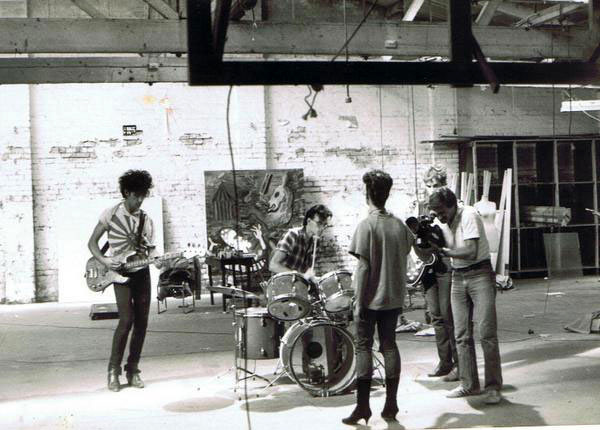
Marching Girls' video shoot for 'My Friends', 1983. - Ken Cooke
A week or so later, we left to play in Auckland. It would be the last Marching Girls tour with Ronnie. On the last day of the tour we played an afternoon show at the Windsor Castle and all got a bit drunk. Des and I took a break to sober up a bit, but Ronnie had vanished. Later that night we were supposed to be doing the last gig of the tour at Mainstreet. As it got close to the time we were due on stage, there was still no sign of Ronnie. I asked around. Someone said they had seen him at passed out at [Features’] Jed Town’s place. Jed lived not far from Mainstreet so I went there to see if I could find him. Sure enough there he was… out cold on the floor.
We tried everything to wake him with only limited success. At least he was on his feet. I helped him stagger back up the road to the venue and got him onto the stage where he lurched and stumbled through the set. It was one of the worst gigs I’ve ever done and for the first time, I think we all knew it was coming to an end.
Once back in Melbourne, he moved into a house in North Melbourne with Lisa. We did a few more gigs but no one’s heart was in it. Jed and James Pinker were in Melbourne and stayed at Ronnie and Lisa’s house. It was here that Ronnie started to record onto a quarter-inch reel-to-reel he had bought. I think they did a few songs together and his songwriting style evolved. The last couple of songs of his we did in Marching Girls were great. Different tunings and a completely different feel to anything we’d done before. Then one night I was at a gig at Melbourne University with Des, when someone asked what I was going to do now that Ronnie had left? I had to ask what they were talking about – this was the first I’d heard of it! He changed his name back to Brendan and started Dead Can Dance with Lisa, Des and Paul Erikson.
Marching Girls split for a while then reformed and continued on and off for some years, adding (and losing) several members. Their recordings included the ‘Plain Jane’ single (1985) and an EP, Safe As Houses (1987).
Tell me about the French trip (and other overseas Marching Girls trips in the 80s and how the records happened – Safe As Houses was recorded at the Super Bear Studios in Paris.)
The French trip was due to Ned Deraad. He was a silent partner in Dave Russell and Wally Wilkinson’s management company, NIDUS. He became more involved with a later version of Marching Girls with Bryan Colechin and Debbie Schulze.
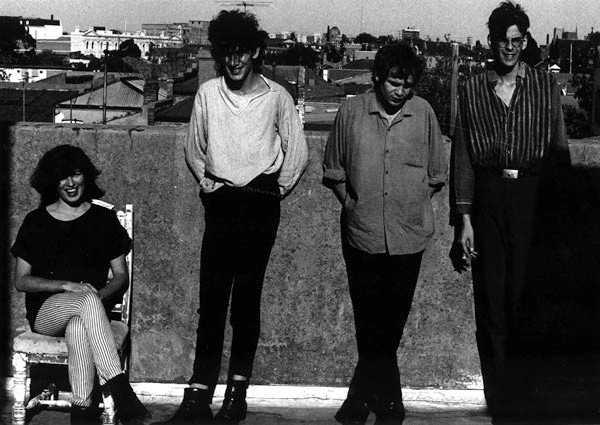
The second version of Marching Girls. From left: Debbie Schulze, Bryan Colechin, Johnny Volume, Des Truction. - Ken Cooke
Ned suggested we record at [Melbourne studio] Richmond Recorders around 1982 or 1983. It was his idea that Des and I should find a replacement for Brendan and reform the band. He’d calculated that we could make a “lot of coin”. Ned was a businessman who saw the music industry as a way to either make a lot of money or as a tax write-off. He took me to America with the demos we’d just recorded, and we visited all of the major labels in Los Angeles. The response was surprisingly good. Five of the songs were chosen by a panel of A&R people at a meeting at the Los Angeles Songwriters Guild, for further talks. They were looking for songs for the next Janet Jackson album but were impressed enough by our songs and the audience reaction that they asked to talk to us at the end of the night. The next day we visited the A&R managers at Capitol, WEA and A&M.
They were all very enthusiastic, especially A&M who spoke of a US$40,000 development advance. Ned in all his wisdom decided he was going to outsmart the labels and record a single ourselves with an overseas producer, then lease the recording to one of the American companies. We actually ended up heavily in debt in spite of getting what was supposedly the largest advance paid by a publishing company at that time. We didn’t see any of that money and Des and I are still paying it back. The band played on for a while until everyone lost interest and started playing in other bands. Debbie got pregnant and couldn’t tour to promote the ‘Plain Jane’ single EMI had just released, so once again we called it quits.
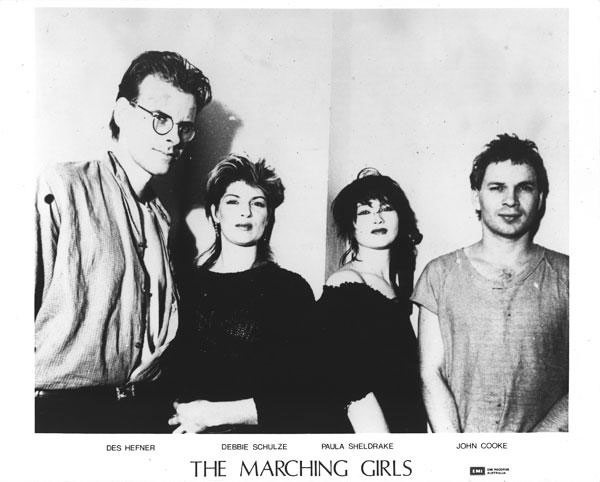
Marching Girls in an EMI publicity shot, mid-1980s.
Then, Ned was at the Melbourne Cup one year. It must have been around 1985. He met an English guy there, Damon Metrebian, who he shared a couple of interests with – gambling and the music biz. Damon also owned a recording studio in Nice in the south of France.
Ned came to visit me the next day with a proposition. If Des and I could put together a new band and record some demo tapes, we could go to France and record an album at his newfound business friend’s studio.
He suggested Paula Sheldrake, who had been playing bass with us in the last version of the band, should try singing. NIDUS had long ago dissolved and Ned now owned the 8-track mobile recording studio. He said he’d unload all the equipment in my bedroom, and I could record some demos for Damon. I hadn’t ever operated multi-track recording gear before, so I took a crash course from an engineer friend.
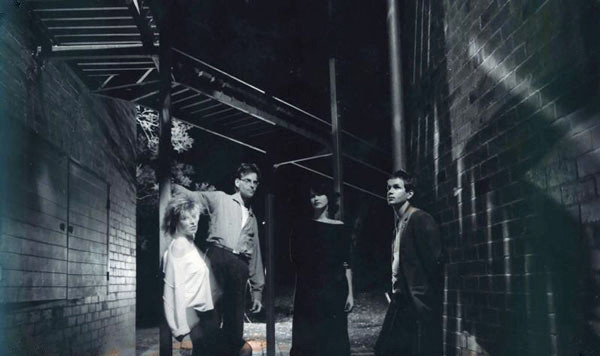
Marching Girls in the mid-1980s: Debra Schulze, Des Hefner and Paula Sheldrake and Johnny Volume. - Ken Cooke
Three weeks later, I’d managed to record six new songs using a drum machine, a sampling keyboard played by Matthew Heydon, myself on guitar with Paula playing bass and doing the vocals with Des. Matthew was a young guy I’d met when his band recorded at my studio in Hardware Street. Matthew was a brilliant, inventive, keyboard player and his band were great, but they broke up after the bass player went mad and stabbed someone, so I asked him to join Marching Girls.
Damon was impressed enough with the demos to offer us a recording date: six weeks in January/February 1986 at Super Bear. The studio was high up in the hills near a village called Berre-Les-Alpes, with the Swiss Alps as a backdrop. Queen, Pink Floyd, Elton John, Kate Bush and many others had recorded there. It all sounded good in theory but turned out to be a nightmare. Damon was clever ... it all had to go exactly the way he had planned it. Ned and Wally were there too, and of no help. Things became very tense. We had a huge falling out and I made a dramatic departure.
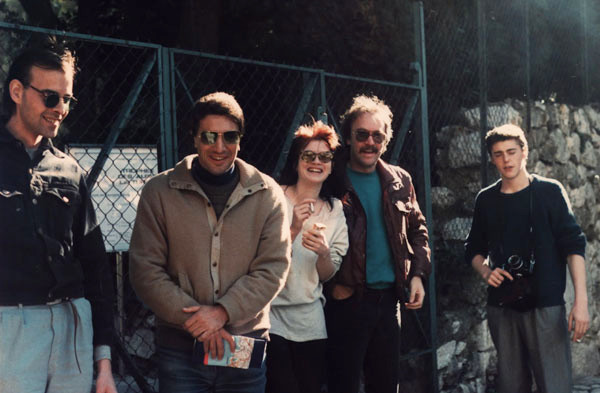
Marching Girls in Monaco. From left: Des Truction, manager Ned Deraad, Paula Sheldrake (bass and vocals), manager Wally Wilkinson, Matthew Heydon (keyboards). - Ken Cooke
The end result was laughable. It sounded like shit and no one wanted anything to do with it. My only consolation was that I hadn’t played a single note on it – Damon had wiped my efforts and played everything himself. I left the band and stayed in London for a few months.
Ned had a lot of money invested in that trip and he wanted to recoup as much as he could, apart from it being a tax write-off. So he once again approached all the major labels in Sydney. PolyGram was interested and said they would release ‘Safe As Houses’ as a single first, then do an album. I was asked to reform the band but only agreed on the condition everything would be remixed and partially re-recorded to our liking. We went into Platinum Studios in Melbourne to dissect the 2" tapes and realised the way Damon had recorded everything made it almost impossible to deviate from his arrangements. However, we added new drum tracks and new guitar samples played on the Mirage. It sounded closer to how it had originally been. The budget ran out while we giving the same treatment to the B-side. We played a few gigs around Melbourne until everyone including the record company lost interest again and that was that.
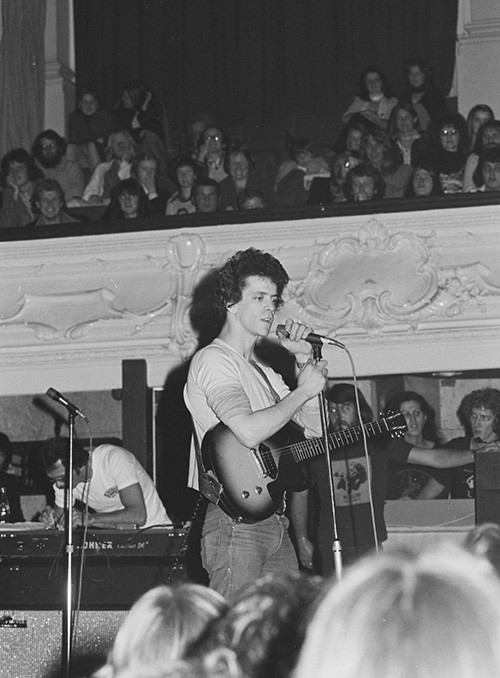
Lou Reed performing at Auckland Town Hall, 7 August 1975. The guitar is the 1957 Les Paul Junior, later owned by Johnny Volume. - Photo by Roy Emerson. Auckland Libraries Heritage Collections 1959-018-10.
Finally, Johnny’s Gibson Les Paul Junior guitar was the stuff of New Zealand punk legend. Not only was it a stunning 1950s original, but it had, so rumour had it, once been owned by Lou Reed.
Whatever happened to that Les Paul? How did you get it, and do you still have it?? I do remember you breaking it when you dropped it at a practice in 1978. I seem to recall there were pics of Lou playing it, too.
I walked into a guitar shop in Auckland and the owner, Mr Alan Kingsley-Smith invited me to come to the storeroom and look at a guitar he thought I might be interested in... it was a 1957 Gibson Les Paul Junior, the first I'd seen in person. Of course, I said I wanted it, so I bought it for $750. It was a lot at the time, but I was in love. The next day, I traded another guitar and raised enough cash to make it mine.
As I was walking out with it, Alan casually mentioned it had belonged to someone called Lou Reed and asked if I'd heard of him.
I don’t have it anymore. The headstock had been broken off a couple of times before I owned it. I didn’t know about such things back then … in fact, I didn’t know it had been broken and repaired when I bought it!
I had it repaired by Mr Zettwitz, an old luthier with a shop on Karangahape Road. I loved going there. He made, repaired and sold violins mainly, but often had some nice old guitars, and probably was the only luthier capable of repairing a broken neck in Auckland at the time. He showed me where the neck had been broken twice before and someone had routed a couple of slots and inserted ebony rods. So, when I broke it that was the third time.
The repair lasted me until about 1980 when Marching Girls were in Melbourne. The last break happened one afternoon when we were sitting around playing guitars in the house we lived in in Carlton. We used to play nearly every day back then. Sometimes we’d jam on other people’s songs that we liked. We were playing a Motown song with a guitar riff that I was having trouble mastering, and I thumped the body with the back of my hand in frustration. At that moment, the head just fell off. Amazing. It must have been one vibration away from falling apart. I took it to a local guitar shop to get repaired, but they told me it was beyond repair. Instead, they could make and attach a new headstock for some phenomenal price that I couldn’t afford. The other option they said was to sell it to them, and they offered me $400 for it. I said I’d have to think about it. I paid Kingsley-Smith about $750 for it. That was quite a bit of money back then. Anyway, this weird thing happened, and I’m still not sure to this day whether or not I was swindled.
The next day, I was visited by a guy I only vaguely knew. He played in a band and worked part-time in the guitar shop. He said he’d heard about my guitar and that he’d give me $500 for it – he was almost begging, so I said okay and sold it to him. I never saw him or the guitar again, but I heard a short time later that he went completely deaf!
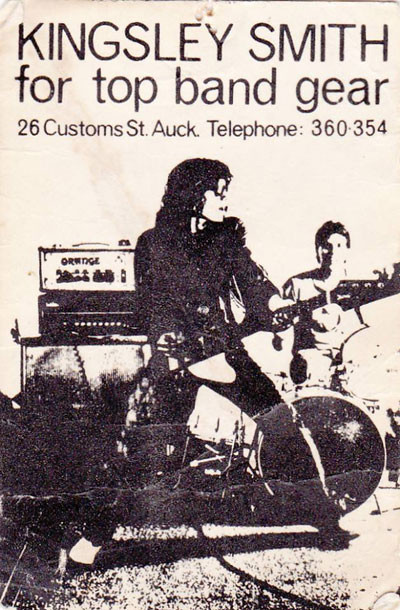
Kingsley Smith business card, designed by Johnny Volume. - Ken Cooke
I ended up buying a 1965 Gibson Firebird III with three P90s and realised it sounded like crap compared to the Junior, which had the same pick-up but a thicker body and a way better sound. I got rid of the Firebird eventually but that’s the guitar I used on the [1980] ‘True Love’ / ‘First In Line’ single.
The Lou Reed story – I went into Kingsley-Smith’s one day on my way home. I used to visit there nearly every day when it was next to ATI and later when they moved to Customs Street. It happened to be next to my bus stop when I lived in Mount Eden.
I’d ordered an Ibanez Les Paul TV copy and they were importing it for me. I went in one afternoon see if it had arrived and Alan asked if I’d like a real Les Paul Junior instead. Of course, I answered “yes” so he told me to come in tomorrow. The next day I went to the shop and he took me out the back and opened a case. There it was. The first Les Paul Junior I’d seen in person. It was the most beautiful thing I’d ever seen. It even smelled great – the scent of its slowly disintegrating Nitro-Cellulose finish. I knew it had to be mine no matter what the price.
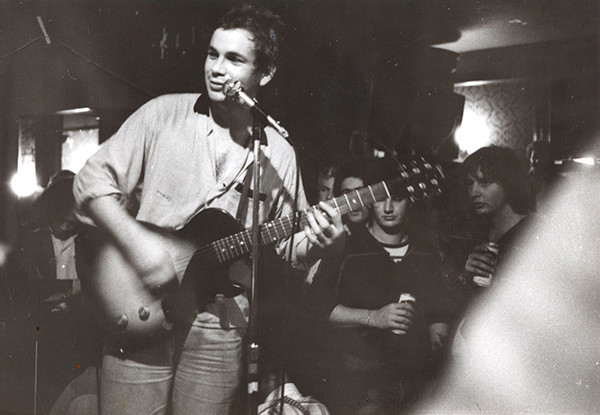
Johnny Volume with his Les Paul Junior, Windsor Castle 1978. - Murray Cammick
He offered me a good trade-in price for my Dan Armstrong Plexiglas copy, and I managed to scrape together the rest. While he was writing out a receipt, he matter-of-factly told me the story about the guitar. The person he’d bought it off had just returned from overseas and told him that he’d swapped another guitar for it in London from “some guy called Lou Reed”. He asked if I'd ever heard of him. I smiled and replied, “Yeah I think I’ve heard the name somewhere.”
I once had a black and white 8 x 10 photograph of Lou playing it. I was pretty certain that Murray Cammick gave it to me, but I asked him about it recently and he has no recollection. I had that photo up until our going away party at my place in High Street when unknown to me Ross and Pete [Townshend] swapped all my stuff to Annie Oakley for a bottle of Jim Beam. I only found that out when I met Annie in Sydney years later and she told me she had all my photos and most of the clothes I'd worn in The Scavengers. I’d sometimes wondered where all my stuff had gone. She told me she’d carried it all around with her for years, but I could have it all back if I wanted. By now she was a homeless alcoholic. We arranged to meet the next day, but she didn’t show, and I had to go back to Melbourne. About a week later I heard she had died. That was really sad news and I guess my stuff ended up in a rubbish bin.
--
Johnny Volume lives in London, where he moved in 2013 from Melbourne. He is a luthier who also trades and repairs classic guitars at http://guitar-yard.com